KSA The Influence of Mother Tongue Interference on the Translation Process
Abstrak
NA
Referensi
Al-Badawi, Khalid. (2012). An analysis of phonetic, morphological and syntactic errors in English: A case study of Saudi BA students in King Khalid University. International Journal of Social Science and Humanity, 2, (6) 536-538.
Baker, M (1992). In other words: A course book on Translation, New York: Routledge.
Benjamin, W. (1968). The Task of the Translator, in Illuminations, ed. H. Arendt, trans. Harry Zohn, New York: Schocken, pp. 69-82.
Benson, C. (2002). Transfer cross-linguistic influence: Key concepts. Oxford: Oxford University Press.
Benson, C. (2002).Transfer cross-linguistic influence: Key concepts. Oxford: Oxford University Press.
Bose, M. (2005). English language teaching (ELT) for Indian students. Chennai: New Century Book House.
Brown, H. (2007). Principles of language learning and teaching. (5th ed). New Jersey: Pearson Educated Limited.
Catford, J. (1995) “A linguistic Theory of Translation”. London. Oxford University Press.
Classe, O. (2000). Translation loss. In Encyclopedia of literary translation into English. (Vol.2, P1419). USA: Fitzroy Dearborn Publishers.
Corder, P. (1981). Error analysis and interlanguage. Oxford: Oxford University Press.
Dweik, (2013). Translating cultural and literary expressions from English into Arabic. Sayyab Translation Journal, 5, 57-70.
Emery, P.(1997). Omani proverbs: problems in translation. In R.
Smith & Erarslan, A. & Hol, D. (2014). Language interference in English: Transfer in the vocabulary, tense, and preposition use of freshmen Turkish EFL learners. ELTA Journal, 2, (2) 4-22.
Gaber, J.(2005). A textbook of translation: Concept, Method and practice. Al-Ain, UAE: University Book House.Great Britain: Short Run Press Limited, Exeter.
Lefevere, A. (1992a). Translation, Rewriting and the Manipulation of Literary Fame, London, and New York: Routledge.
Maier, R. (2008). Structural interference from the source language: A psycholinguistics investigation of syntactic processes in non-professional translation. (Unpublished Doctoral dissertation). University of Edinburgh, Scotland.
Mitchell, R. & Myles, F. (2004). Second language learning theories (2nd ed). London UK: Hodder Arnold.
Munday, J. (2001). Introducing Translation Studies: Theories and Applications, London and New York: Routledge.
Newmark, (1988). A textbook in translation. Hartford- shire: Prentice Hall.
Nida, Eugene A. “A Framework for the Analysis and Evaluation of Theories of Translation". In R.W. Brislin. 1976.
Venuti, L. (ed) (2004). The Translation Studies Reader. London and New York: Routledge.
Yowell & Muftan (1999) “Principles of Translation”. Cairo: Dar Annahda Alarabiya.


 This work is licensed under
This work is licensed under